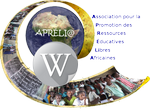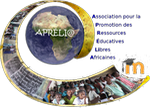Chapter 1 : Our Partners’ Class and School
 The Apréli@ Network
The Apréli@ Network
Educative e-Twinnings
Chapter 1 : Our Partners’ Class and School
Back to Travel Diary Mod : Who is who Ch 1 Ch 2 Ch 3 Ch 4 Ch 5 Ch 6 Ch 7
Notes:
- Before you start working with classes, use this guidance sheet as a basis to finalise the work instructions and schedules in cooperation with your colleague in the partner school. Make sure you record your decisions.
- At the bottom of this page you will find versions of the chapter: the pdf version allows you to print without making any changes, the doc or odt versions allow you to make the changes you wish to make, and then print if you want.
- All exchanges of documents between partners are done by email or by using a shared virtual space, such as Dropbox (https://www.dropbox.com/)
-
prepare an electronic document Our partners’ class and school. The document which will contain with texts, pictures will present the partners’ class and school, insisting on the differences with their own.
-
produce a poster on the partners’ class and school that will be displayed in the school.
This will allow them to discover their partners’ school: its working conditions, important places, actors, teaching and administrative organisation.
- Overall objectives
Pupils learn to collect, compare, and classify information.
-
Specific objectives
Pupils will be able to:
- discover their partners’ class, the school members, the classroom organisation, the school life, the teaching and learning and educational methods and compare them with their own.
-
learn to compare and contrast
-
learn to accept and appreciate differences.
-
Local objectives (to integrate the work on this chapter to the school curriculum)
-
relevant school subjects:
.
.
-
teaching and learning objectives:
.
.
-
Information technology objectives
Use multimedia tools (text and photos) to present the partners’ class and school.
1. Preparation
-
Each class will ask the partner class to provide a range of details about its class and school.
-
For this purpose, each teacher organises a brainstorming session with his/her class (download from the TESSA key resources page) to establish a consensus list of desired information ("What do I want know about my partners’ class? About their school? On how a typical day is organised? On their holidays? On how they are assessed? etc.)
-
The final list is then sent to the partner class.
2. Working on answers
-
On receiving the partners’ questions the whole list is read by the class and the questions organised in themes. The class is divided into groups (one per theme). See the TESSA Key Resource on group work: Using group work in your classroom
-
Each group is responsible for answering questions about one theme (or two if there are more themes than groups) and works on providing answers for its theme questions.
-
The class sends its answers to the partner class.
3. Requesting more information
-
Each class considers the information received from its partner class and draws out 10 subthemes up from the information sent by its partners (for instance: school time, assessment, break time, school holidays, etc.)
-
The class is divided into groups (See TESSA Key Resource on Group work), one per theme.
-
Each group lists the information it still requires to make their presentation on the items selected.
Example : In your school, there are no toilets for girls, so, how do they manage? In your class, there are far fewer girls than boys, why? etc
-
The class sends its requests for further information to the partner class.
4. Providing more details
-
The groups provide the requested information on the items for which they are responsible.
-
The information is sent to the partner class.
5. Preparing the Digital Travel Diary chapter for publication
-
The groups write a text for the sub-theme for which they are responsible, texts are then keyed in and saved, with one or several illustrations, where appropriate.
-
All documents are sent to the partner class.
6. Validating the Digital Travel Diary chapter for publication:
-
The partners read the documents received on their school and class, suggest additions or changes (if necessary) before returning them.
7. On receiving corrections and modifications:
-
Pupils complete their chapter.
-
They select the texts and images for the poster and display the texts and images on the poster.
The final products are available
-
Chapter 1 of the Digital Travel Diary Our Partners’ Class and School, well written and well presented, and made available to the partner class.
-
1 or 2 well written and well presented poster(s) in the place that the class deems most appropriate.
-
Pupils make a slideshow (e.g. PowerPoint) presenting their partners’ school and class, incorporating sound and video documents if appropriate, and show it to other classes, parents, school partners.
-
The teacher takes advantage of the pupils’ questions and thoughts to make the link with the MDGs (Millennium Development Goals) 2 and 3:
-
Objective 2 : Achieving universal primary education
-
Objective 3 : Promoting gender equality and empowering women
-
The teacher and pupils review the objectives set for this chapter, decide whether these have been achieved and how they know it.
-
They consider what they have learned while completing this chapter, and how they can demonstrate what they have learned.
-
A computer with an Internet connection
-
A word processing package
-
A presentation software package (optional)
-
A digital camera - or a mobile phone that takes pictures.
-
Apréli@ e-twinning Chapter 1: Our partners' class and school
-
TESSA Key Resource - Using Mind Maps and Brainstorming to Explore Ideas: http://www.tessafrica.net/files/tessafrica/kr_brainstorming.pdf
-
TESSA Key Resource – Using Group Work in Your Classroom: http://www.tessafrica.net/files/tessafrica/kr_groupwork.pdf
-
Millennium Development Goals http://en.wikipedia.org/wiki/Millennium_Development_Goals
Select objective 2 Achieving universal primary education and objective 3 Promoting gender equality and empowering women
Back to Travel Diary Mod : Who is who Ch 1 Ch 2 Ch 3 Ch 4 Ch 5 Ch 6 Ch 7 To the top
| Home-page | The Teacher Educator's Resources (in French) |
TESSA pedagogical support | IFADEM computer literacy (in French) |
Educational resources of e-twinning @ Apréli are under Creative Commons license level 5:
paternity, not commercial use, sharing the same initial conditions
(See http://creativecommons.org/licenses/by-nc-sa/2.0/fr/)

